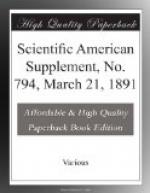That the contribution of heredity to consumption is great is undoubtedly the case, and, more than any other factor, it would seem to have a directing power in the army of inducing evils. But the fact that the greater number of the offspring of consumptives escape the disease, even where the general family resemblance is quite pronounced, is readily explained by the difference in personal habits, the circumstances of different periods or the domestic regulations instituted by medical counsel. Also the fact that consumptives so frequently spring from neurotic parentage and the victims of dissipation, especially alcoholic, still farther goes to show that the hereditary element is essentially a reduced power of resistance to formative evils, and that as a negative condition it may hold the balance of power in focusing the forces. Thus, heredity, in disease, can be understood as in no sense implying a specific force, but rather an atonic or susceptible condition, varying in its precise character and producing a pars minoris resistentiae—a special weakness in a special way.
That the germ bacillus does not originate consumption there can be no doubt, unless consumption is not to be regarded as a disease until it is full fledged, for otherwise the germ would be present in the earlier formations, as well as the later, which, according to good authority, is not the case. But that this parasite has a special affinity for consumptive tissue there is no question, and that it thrives therein with great rapidity, hastening retrogressive changes, is also to be granted. But, as yet, this is all we are entitled to believe.
We thus see that the lines of successful treatment must be both constitutional and local; that the constitutional cannot be specific, and the strictly local cannot be curative. The constitutional must be of a negative and positive character, having regard to the support of the healthy remnant, and which will require correction of any deficiency whatsoever in order to remove the morbid constitutional habit. The local will be cleansing of the affected organs from the germs and morbid products.
The evident selective affinity of Koch’s lymph for tuberculous tissue may enable it, in certain cases, to effectually seal the arterial capillaries about the affected parts, owing to the intense vaso-motor disturbance produced. This would starve the germs, which, with the tubercular matter, may be expectorated through the moisture and motion of the lungs. In incipient cases the tubercles might be as readily absorbed as catgut ligature, and the germs, if any, fall to phagocytic prey. The Koch lymph is evidently not a poison to the germs, and probably has no other action on the affected organs than that of an irritant, having a selective affinity by virtue of the kinship with its contents. This theory of its action is supported by our common knowledge of the power of pyogenic agents to awaken old or slumbering inflammations, and the fact that septic fevers, such as small-pox, have been known to leave the consumptives with the last stages free from every symptom.




